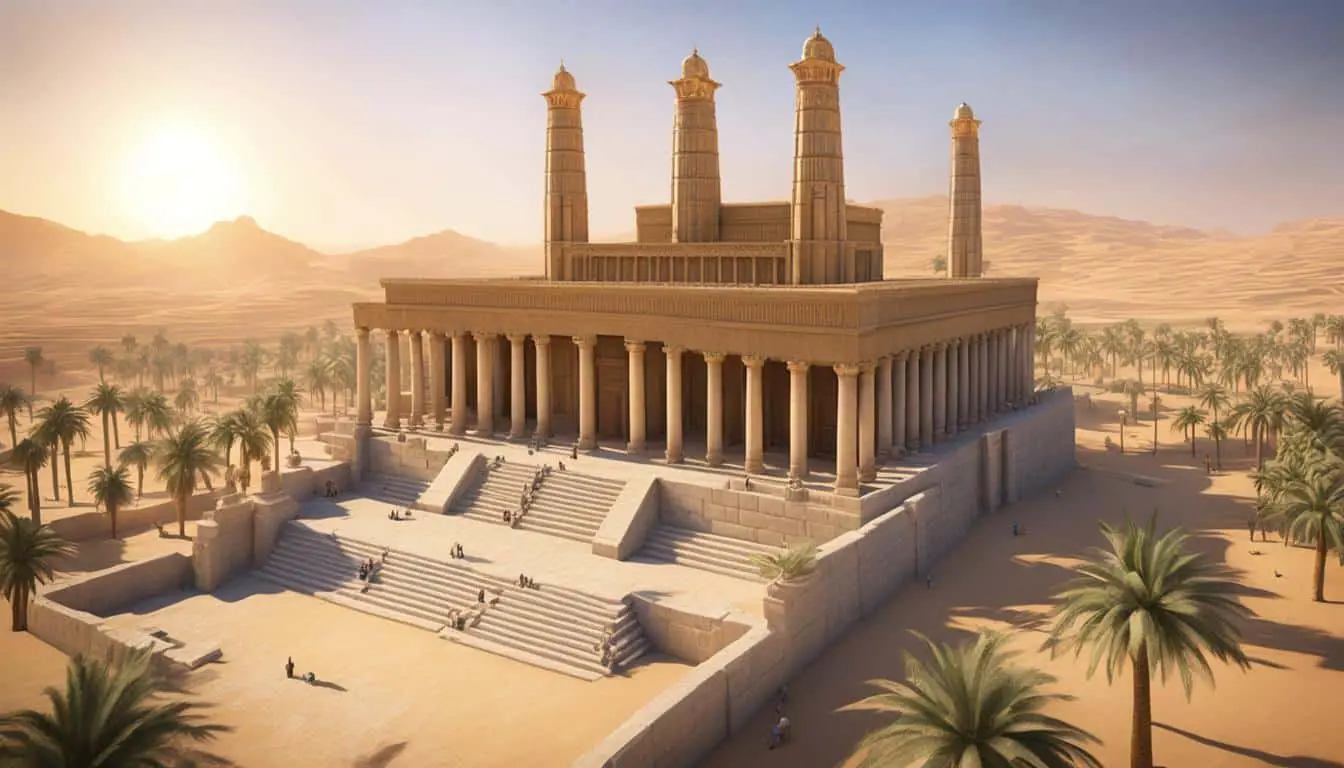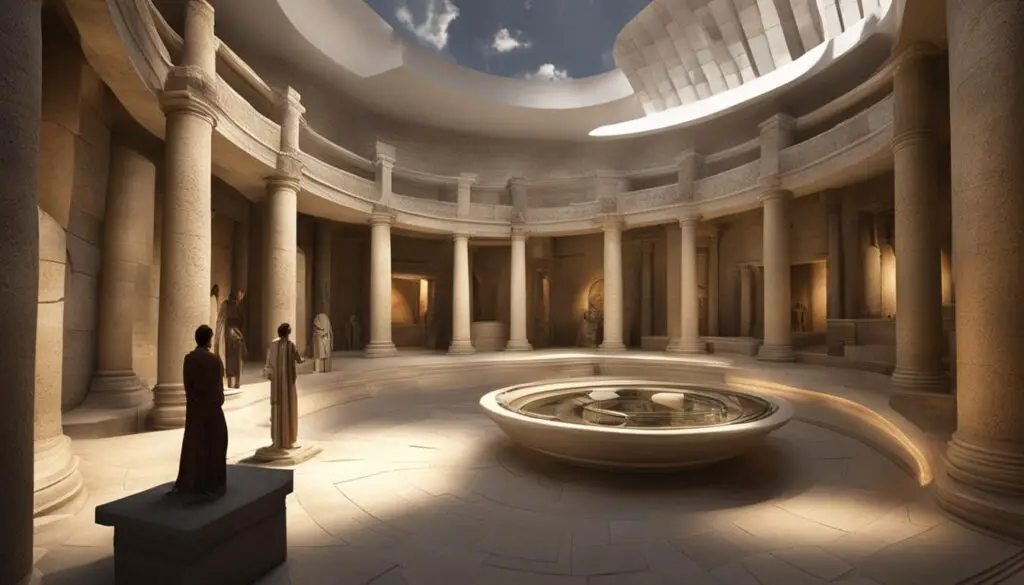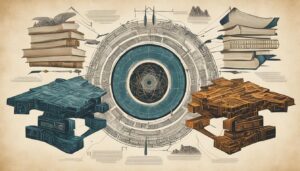
I am thrilled to introduce you to the fascinating world of virtual reconstructions of biblical-era buildings. With cutting-edge technology, we can now visualize and explore the architectural wonders of ancient civilizations like never before. Through meticulous research and digital modeling, experts have created realistic virtual models of historical structures, offering valuable insights into the culture, lifestyle, and religious practices of the ancient world.
Virtual reconstructions have become an essential tool in understanding and appreciating the magnificent architecture of biblical times. These immersive experiences allow us to step back in time and witness the grandeur of ancient buildings with remarkable historical accuracy. By reconstructing these structures virtually, experts can delve into the intricate details, construction techniques, and overall layouts of these architectural marvels.
The process of virtual reconstruction begins with extensive historical research, where experts gather architectural knowledge from historical records, archaeological findings, and relevant texts. With this information, digital models are created using advanced software and 3D rendering techniques. The virtual models are refined and adjusted based on further research and feedback from experts in the field, ensuring the utmost accuracy in the reconstruction.
Virtual reconstructions offer numerous benefits in the field of archaeology and cultural heritage preservation. They provide a means of documenting and preserving ancient structures that may have been lost or damaged over time. Additionally, virtual reconstructions make historical buildings more accessible to the public, allowing people from all around the world to appreciate the architectural wonders of the past. Moreover, these virtual reconstructions serve as powerful educational tools, offering insights into the history, art, and culture of biblical times.
Virtual reconstructions find applications in various fields, including museum exhibits, academic research, and the entertainment industry. Museums utilize virtual reconstructions to create immersive exhibits that breathe life into ancient buildings. In academia, virtual reconstructions contribute to further research and understanding of biblical architecture. Virtual tours of historical sites and religious buildings provide valuable resources for students and scholars of religious studies. Furthermore, the entertainment industry harnesses virtual reconstructions in films and documentaries to recreate historical settings and enhance storytelling.
Undoubtedly, challenges remain in achieving the highest level of accuracy in virtual reconstructions. It requires precise historical data and interdisciplinary collaboration between archaeologists, historians, architects, and digital modeling experts. However, with advancements in technology, new tools and techniques are continuously being developed to enhance the realism and interactivity of these virtual experiences. The future holds promising possibilities for even more immersive and accurate virtual reconstructions of biblical-era buildings.
In conclusion, virtual reconstructions have revolutionized our understanding of ancient architecture. Through cutting-edge technology and meticulous research, these virtual models bring the architectural wonders of biblical times to life. By embracing these virtual reconstructions, we can unravel the mysteries of the past and connect with the rich history of our civilization.
Key Takeaways:
- Virtual reconstructions use cutting-edge technology to bring biblical-era buildings to life.
- These reconstructions offer valuable insights into ancient culture, lifestyle, and religious practices.
- Virtual reconstructions help researchers and experts understand and analyze architectural details with historical accuracy.
- They provide means of preserving and documenting ancient structures that may have been lost or damaged.
- Virtual reconstructions make historical buildings accessible to the public and serve as educational tools.
The Importance of Virtual Reconstructions
Virtual reconstructions play a crucial role in helping us understand and appreciate biblical architecture. They enable researchers, historians, and archaeologists to study and analyze historical buildings with a high level of accuracy.
By reconstructing these structures virtually, experts can gain insights into architectural details, construction techniques, and the overall layout of biblical-era buildings. This attention to historical accuracy allows us to better understand the ingenuity and craftsmanship of the builders of the past.
Furthermore, virtual reconstructions provide an immersive experience for viewers, allowing them to step back in time and visualize the grandeur of these ancient structures. Walking through a virtual biblical-era building transports you to a different time and place, creating a sense of connection with history and culture.
Whether it’s exploring the intricate design of a temple or marveling at the scale of a palace, virtual reconstructions provide a unique opportunity to experience biblical architecture firsthand. These immersive experiences foster a deeper appreciation for the architectural achievements of ancient civilizations.
The Process of Virtual Reconstruction
Virtual reconstruction of historical buildings requires a meticulous process that combines historical research, architectural knowledge, digital modeling, and 3D rendering techniques.
First and foremost, researchers embark on extensive historical research to gather information about the building in question. This involves studying historical records, examining archaeological findings, and analyzing relevant texts. By delving into the rich archives of history, researchers aim to gain a comprehensive understanding of the structure and its context.
With a wealth of historical data at hand, the next step involves leveraging architectural knowledge to translate the information into a digital model. This process often requires the expertise of architects, who possess a deep understanding of building design, construction techniques, and spatial layouts.
Using advanced software and 3D rendering techniques, experts transform the historical data and architectural knowledge into a digital model. This digital model serves as the foundation for the virtual reconstruction, capturing the intricate details, proportions, and textures of the ancient structure.
“Virtual reconstruction is a fascinating blend of historical research, architectural expertise, and cutting-edge technology. It allows us to bring ancient buildings back to life and gain a deeper understanding of our past.” – Dr. Emily Johnson, Historian
The digital model is often refined and adjusted based on further research and feedback from experts in the field. This iterative process ensures the accuracy and authenticity of the virtual reconstruction, as researchers constantly strive for historical fidelity and attention to detail.
By integrating historical research, architectural knowledge, digital modeling, and 3D rendering, virtual reconstruction offers a powerful and immersive experience that allows us to step back in time and explore the architectural wonders of the past.
| Benefits of the Process | Details |
|---|---|
| Accuracy | The process of virtual reconstruction ensures a high level of accuracy, capturing the intricate details and proportions of historical buildings. |
| Authenticity | Iterative refinement and expert feedback help maintain the authenticity of the virtual reconstruction, creating a faithful representation of the past. |
| Visualization | Virtual reconstructions provide a visual medium to explore and comprehend historical architectural design and spatial layouts. |
| Educational Value | Through virtual reconstructions, students, scholars, and enthusiasts gain valuable insights into the history and culture surrounding these buildings. |
Thanks to the painstaking process of virtual reconstruction, we can now delve into the architectural achievements of ancient civilizations, unlocking a deeper understanding of our shared human heritage.
Benefits of Virtual Reconstructions
Virtual reconstructions offer numerous benefits in the field of archaeology and cultural heritage preservation. These digital models provide a means of preserving and documenting ancient structures, ensuring that valuable architectural wonders are not lost to time. Through virtual reconstructions, historical buildings become accessible to people from all around the world, allowing them to explore and appreciate the cultural significance of these structures.
Moreover, virtual reconstructions serve as valuable educational tools, offering insights into the history, art, and culture of biblical times. By immersing themselves in these virtual environments, students and enthusiasts can gain a deeper understanding of the past. Virtual reconstructions act as a bridge between the present and the past, allowing us to connect with our cultural heritage in a tangible and engaging way.
Virtual reconstructions not only preserve architectural heritage but also serve as educational tools, enabling a wider audience to appreciate and understand the buildings of the past. Through these digital recreations, individuals can explore the intricate details of biblical-era structures, gaining a profound insight into the civilizations that constructed them. This accessibility fosters a greater appreciation for cultural heritage and encourages further exploration of our shared history.
Preservation of Cultural Heritage
One of the primary benefits of virtual reconstructions is the preservation of cultural heritage. By creating digital models of ancient buildings, we can safeguard their architectural details and prevent their loss due to natural disasters, decay, or human interference. These virtual reconstructions act as a digital archive, ensuring that future generations can appreciate and study our rich cultural history.
Accessibility to a Global Audience
Virtual reconstructions break down the barriers of distance and access, making historical buildings accessible to a global audience. Through the power of the internet, individuals from all corners of the world can virtually explore and engage with ancient structures. This accessibility fosters a greater appreciation and understanding of diverse cultural heritage, transcending geographical boundaries.
Valuable Educational Tools
Virtual reconstructions serve as valuable educational tools, offering unique opportunities for learning. Students, researchers, and enthusiasts can delve into these digital environments to study historical architecture, learn about construction techniques, and gain a deeper understanding of the people who lived in these buildings. It brings history to life, making it engaging and relatable for learners of all ages.
As we continue to advance in technology and research methodologies, virtual reconstructions will play an increasingly crucial role in preserving our cultural heritage and fostering a deeper understanding of our past.
Applications of Virtual Reconstructions
Virtual reconstructions have found extensive applications in various fields, showcasing their versatility and significance. From museum exhibits to academic research and the entertainment industry, virtual reconstructions have revolutionized the way we engage with historical architecture and immerse ourselves in the past.
1. Museum Exhibits
Museums have embraced virtual reconstructions as a means to create immersive exhibits that transport visitors to ancient times. By integrating cutting-edge technology and realistic virtual models, museums can bring historical buildings to life, enabling visitors to explore and experience the architectural wonders of the past. These virtual exhibits provide a unique opportunity to engage with ancient structures and gain a deeper understanding of their historical and cultural context.
2. Academic Research
Virtual reconstructions serve as invaluable tools for academic research and furthering our understanding of biblical architecture. Researchers and scholars can utilize these reconstructions to study and analyze historical buildings with a high level of accuracy and detail. By virtually reconstructing architectural wonders from different time periods, experts can uncover architectural techniques, explore spatial layouts, and gain insights into the cultural and religious practices that shaped ancient civilizations.
3. Virtual Tours
Virtual tours of historical sites and religious buildings offer a unique opportunity to explore these structures from anywhere in the world. Students and scholars of religious studies can virtually visit sacred sites, gaining access to invaluable resources for their research and education. Through virtual tours, individuals can study the intricate details of religious architecture, understand its symbolism, and delve into the rich history and traditions associated with these sites.
4. Entertainment Industry
The entertainment industry has harnessed the power of virtual reconstructions to recreate historical settings and enhance storytelling in films and documentaries. By utilizing realistic virtual models, filmmakers can accurately depict ancient environments, providing viewers with a visually captivating experience. Whether recreating biblical landscapes or ancient cities, virtual reconstructions bring authenticity and depth to historical narratives, transporting audiences to different time periods.
“Virtual reconstructions have transformed the way we engage with history, allowing us to explore and experience the architectural wonders of the past in unprecedented ways.”
Whether it’s for educational purposes, museum exhibits, academic research, or the entertainment industry, virtual reconstructions have become a pivotal tool in understanding and appreciating ancient architecture. By combining technological advancements with historical knowledge, these reconstructions provide us with a window into the past, enabling us to immerse ourselves in the rich cultural heritage of civilizations long gone.

Challenges and Future Developments
Despite the advancements in virtual reconstruction technology, there are still challenges to overcome. Achieving a high level of accuracy in virtual reconstructions requires precise historical data and interdisciplinary collaboration between archaeologists, historians, architects, and digital modeling experts.
The Importance of Historical Accuracy
Accuracy is paramount when it comes to virtual reconstructions of biblical-era buildings. To ensure the fidelity of these virtual models, researchers rely on comprehensive historical data, including archaeological findings, written records, and scholarly interpretations. This interdisciplinary approach brings together experts from various fields, each contributing their specialized knowledge to create an accurate representation of the past.
“Virtual reconstructions strive to be as accurate as possible, offering viewers an authentic glimpse into the architectural wonders of biblical times. It is through this accuracy that we can truly appreciate and understand the cultural significance of these ancient structures.”
Technological Advancements in Virtual Reconstruction
As technology continues to advance, so does the capability to create more realistic and immersive virtual reconstructions. Cutting-edge software and techniques, such as 3D scanning and modeling, allow for greater precision and detail in capturing the intricacies of biblical-era buildings. The integration of artificial intelligence and machine learning algorithms further enhances the interactive nature of these virtual experiences.

Interdisciplinary Collaboration for Accurate Reconstructions
Interdisciplinary collaboration plays a crucial role in the accuracy of virtual reconstructions. Archaeologists provide historical context and interpret archaeological findings, historians contribute detailed knowledge of the time period, architects offer insights into construction methods and spatial relationships, and digital modeling experts bring these elements together in a cohesive virtual environment.
This collaborative approach ensures that the virtual reconstructions are not only visually stunning but also grounded in historical and architectural authenticity. By combining the expertise of multiple disciplines, virtual reconstructions can provide a comprehensive understanding of biblical-era buildings and their significance in ancient cultures.
The Future of Virtual Reconstructions
The future holds promising possibilities for even more immersive and accurate virtual experiences of biblical-era buildings. Ongoing advancements in technology will continue to push the boundaries of what is possible, allowing for ever more realistic and interactive reconstructions. Additionally, increased interdisciplinary collaboration will further refine the accuracy of these virtual models, providing researchers and viewers with a deeper understanding of ancient architecture and its cultural context.
Conclusion
Virtual reconstructions have revolutionized the way we explore and understand ancient architecture. Through cutting-edge technology and meticulous research, these virtual models bring biblical-era buildings to life, allowing us to step back in time and gain a deeper appreciation for the architectural wonders of the past.
By embracing virtual reconstructions, we can continue to unravel the mysteries of the past and connect with the rich history of our civilization. These virtual models provide valuable insights into the culture, lifestyle, and religious practices of the ancient world, helping us understand our roots and heritage.
As virtual reconstruction techniques continue to improve, they will undoubtedly play an essential role in preserving and disseminating knowledge about our cultural heritage. They contribute to the conservation and documentation of ancient structures, ensuring that they are not lost to time. Furthermore, virtual reconstructions make ancient buildings more accessible to people from all around the world, fostering a greater understanding of different civilizations and promoting intercultural dialogue.
With virtual reconstructions, the past becomes tangible, allowing us to explore and study ancient architecture in ways previously unimaginable. By unlocking the secrets of the past through virtual reconstructions, we can gain a deeper understanding of our roots, appreciate the ingenuity of our ancestors, and continue to learn from their achievements. Virtual reconstructions truly enable us to bridge the gap between ancient history and the present, fostering a greater understanding of our collective human story.
FAQ
What is virtual reconstruction?
Virtual reconstruction is the process of creating realistic digital models of historical buildings using cutting-edge technology. It allows us to visualize and explore architectural wonders from biblical times.
How do virtual reconstructions help us understand biblical architecture?
Virtual reconstructions enable researchers, historians, and archaeologists to study and analyze historical buildings with a high level of accuracy. They provide insights into architectural details, construction techniques, and the overall layout of biblical-era buildings.
What is involved in the process of virtual reconstruction?
The process starts with extensive historical research and the gathering of architectural knowledge. This information is then used to create digital models of the structure using advanced software and 3D rendering techniques.
What are the benefits of virtual reconstructions?
Virtual reconstructions preserve and document ancient structures, make historical buildings more accessible to the public, serve as valuable educational tools, and offer insights into the history, art, and culture of biblical times.
Where are virtual reconstructions used?
Virtual reconstructions find applications in museum exhibits, academic research, virtual tours of historical sites, religious studies, and the entertainment industry.
What are the challenges and future developments in virtual reconstructions?
Achieving high accuracy requires precise historical data and interdisciplinary collaboration. As technology advances, new tools and techniques are being developed to enhance the realism and interactivity of virtual reconstructions.
How do virtual reconstructions revolutionize our understanding of ancient architecture?
Virtual reconstructions bring biblical-era buildings to life, allowing us to step back in time and gain a deeper appreciation for the architectural wonders of the past. They play an essential role in preserving and disseminating knowledge about our cultural heritage.








